Final Report for LS12-252
Project Information
Tropical smallholder farmers that operate under low-external-input (LEI) conditions rely upon non-intensive on-farm or locally available inputs for agricultural production; however, such resources are limited in the tropics and there is sparse data regarding the sustainability of tropical LEI agroecological systems. The primary objective of this study is to identify and evaluate tropical (warm season) cover crops and the subsequent use of cover crop residues as in situ mulch in reduced tillage agroecosystems.
Objective 1, in the U.S. Virgin Islands evaluated five tropical (warm season) cover crop species that included sunn hemp (Crotalaria juncea cv. IAC-1), sun flower (Helianthus annuus, var. black oil), bush pigeon pea (Cajanus cajan cv. BRS Mandarim), sesame (Sesamum indicum, cv. ns), and velvet bean (Mucuna pruriens (L.) DC. cv. Vine 90). Cover crops were compared and their response to mechanical termination with a roller-crimper to produce in situ mulch for weed suppression was determined.
In the U.S. Virgin Islands, sunn hemp produced the greatest biomass levels of the cover crops evaluated within the 90 day period between planting and termination. Pigeon pea produced large amounts of biomass (13,842 kg ha-1), but was slow to develop and took 160 days to flower. Sunn hemp biomass was 7,967 kg ha-1, and had plant tissue N and P content of 2.9% and 0.17%, that resulted in sunn hemp having the highest estimated N and P contribution potential of 231 kg ha-1 nitrogen and 14 kg ha-1, respectively. Both sesame and sunn hemp were effective at suppressing both broadleaf weeds and grass weeds during cover crop establishment. Sunn hemp, sesame, and sun flower were effectively terminated with a roller crimper while velvet bean and pigeon pea were not, as evidenced by substantial levels of regrowth following termination with the roller-crimper. Following termination, sesame and sunn hemp cover crop surface residue has the greatest potential for extending weed suppression for up to six weeks into subsequent vegetable crop rotations.
In Puerto Rico, sunn hemp (Crotalaria juncea L. cv. Tropic Sun) and velvet bean (Mucuna pruriens L. DC. cv. Dwarf) were evaluated as crimped legumes prior to sweet corn (Zea mays L. cv. Suresweet 2011) production and compared to conventional sweet corn production. Overall, sweet corn production systems including crimped legumes had similar corn yields and insect damage as conventional systems. Therefore, production systems utilizing legumes prior to corn production are recommended due to long-term ecological and soil quality benefits of cover crop use and reduced tillage.
Objective 2 in the U.S. Virgin Islands evaluated and compared three cover crop species to each other and to a weedy fallow in rotation with a subsequent no-till hot pepper (Capsicum chinense Jacq.) rotation where the cover crop residue was mechanically (roller-crimper) killed for in situ mulch for extended weed suppression. Cover crops tested included sunn hemp (Crotalaria juncea cv. IAC-1), sun flower (Helianthus annuus, var. black oil), and bush pigeon pea (Cajanus cajan cv. BRS Mandarim). Following cover crop termination, jalapeno peppers were no-till transplanted into cover crop residue mulch or the conventional full-till treatments. Overall, sunn hemp and sun flower provided near 100% weed suppression during the cover crop rotation. Both sunn hemp and sun flower were effectively terminated with a roller-crimper and through in situ mulch, provided similar or greater extended weed suppression for six weeks into the subsequent pepper rotation. Jalapeno pepper yields transplanted with no-till into sunn hemp and sun flower in situ mulch treatments were similar or greater than those in conventional full tillage systems.
In Puerto Rico, Objective 2 evaluated allelopathic effects of aqueous extracts of crotalaria (Crotalaria juncea (L.) cv. Tropic Sun), jack bean (Canavalia ensiformis (L.)) and pigeon pea (Cajanus cajan (L.) cv. Lazaro) was determined on seven agronomic crops: corn (Zea mays cv. Mayorbela 2011), sorghum (Sorghum bicolor), bean (Phaseolus vulgaris cv. Verano), soybean (Glycine max), cowpea (Vigna unguiculata (L.)), lettuce (Lactuca sativa (L.) cv. Nevada) and pigeon pea (Cajanus cajan cv. Dwarf) in the laboratory. Sorghum and lettuce showed growth inhibition of the hypocotyl, coleoptile and radicle when treated with the three aqueous extracts, where, jack bean aqueous extracts showed higher inhibition percentages (66% in lettuce and 49% in sorghum). In contrast, corn, bean and cowpea treated with crotalaria aqueous extracts exhibited growth stimulation.
Objective 3a in Florida and the U.S. Virgin Islands evaluated sunn hemp as a cover crop rotation with pepper production where the crop residue is either mechanically (roller-crimper) killed for in situ surface sheet mulch or is green chopped and soil incorporated to determine effects on soil quality and weed suppression in comparison to three common cultural weed management practices. The four treatments evaluated included sunn hemp residue in situ mulch (no-till), plastic film mulch (full-till), cut and carry hay mulch (full-till), and no mulch (conventional control; full-till). Each plot was divided in half and either low (hand weeding every third week) or high frequency (weekly hand weeding) weeding treatments were assigned to each plot six weeks after planting. In both FL and the USVI, pepper yields were greatest in the cut and carry hay treatment. In FL in 2013, the roller-crimped sunn hemp treatment pepper yields were similar to the plastic mulch and no mulch treatments and in 2014 were similar to the cut and carry hay but greater than the no mulch treatments. This indicates that under Florida conditions, when SH residue is utilized as mulch for subsequent pepper production, pepper yields can be similar to or greater than yields obtained by conventional mulching methods that rely upon full tilage for weed suppression. Florida, pepper yields were unaffected by weeding frequency. This indicates that regardless of the weed management system, fewer weeding events will be economically beneficial.
Objective 3a in Puerto Rico assessed integrated cropping system effects of three living leguminous mulches that included jack bean (Canavalia ensiformis), sunn hemp (Crotalaria juncea), and pigeon pea (Cajanus cajan) intercropped with Maricongo plantain. Integrating legumes as living mulch intercropped with plantain merkedly reduced weeds in between plantain rows resulting in less herbicide applications compared to conventional plantain cropping systems. Intercropped legemes between plantain rows resulted in benifits to plantain growth and establishment parameters.
Objective 3b in the U.S. Virgin Islands evaluated sunn hemp as a cover crop rotation with where sunn hemp is terminated with a roller-crimper and the resulting crop residue is evaluated as in situ mulch, in situ sunn hemp mulch plus landscape fabric, or in situ sunn hemp mulch plus hay mulch for no-till hot pepper production compared to conventional full tillage hot pepper production. Each plot was divided in half and either low (hand weeding every third week) or high frequency (weekly hand weeding) weeding treatments were assigned to each plot after pepper transplant. This project differs from objective 3a in that all experimental mulch treatments are no-till and only the conventional control treatment is full-till. Similar pepper yields were recorded for both low and high frequency weed removal sub-plots. This implies that three week weed removal intervals are generally as effective as weekly weed removal and could greatly reduce weed removal labor costs in organic hot pepper production. Generally, weed biomass in the conventional full-till system and the no-till sunn hemp mulch only treatments were similar and implies that full soil tillage does not necessarily correlate to reduced weed biomass compared to no-till vegetable cropping systems.
Overall, the sunn hemp mulch plus landscape fabric and sunn hemp mulch plus hay mulch treatments had the greatest Jalapeno yields with no differences between the no-till sunn hemp mulch and conventional full-till treatments. Serrano pepper yields were greatest in the sunn hemp mulch plus landscape fabric, SHM+hay, and SH+none treatments. Generally, the greatest pepper yields resulted from no-till in situ sunn hemp mulch plus the application of an additional mulch. This indicates that full tillage field preparation (at the expense of soil quality) is not necessary to ensure high yields when no-till soil conservation practices can be utilized in conjunction with in situ sunn hemp mulch (the addition of supplemental mulch can increase yields further) in organic hot pepper production.
Objective 4 demonstrated and transferred results from the first three objectives to local farmers, agriculture extension agents, and federal agricultural agencies throughout the USVI, PR, and Florida. In the U.S. Virgin Islands, research results and recommendations were presented at two field days that were conducted in 2014 and 2016 at the Agricultural Experiment Station. There were more than 40 participants (farmers, extension and research personnel) in attendance at each field day. In Puerto Rico, research results and recommendations were presented at two field days that were conducted in 2014 and 2015 at the Isabela Agricultural Experiment Station. There were more than 50 participants (farmers, extension and research personnel) that attended both workshops. At the University of Florida an outreach and extension workshop was conducted in 2016 at the Suwannee Valley Agricultural Extension Center near Live Oak, FL. There were a total of 60 farmers, extension agents and agricultural agency personnel that participated in the workshop.
Objective 1; U.S. Virgin Islands: To evaluate five tropcial (warm season) cover crop species that included sunn hemp (Crotalaria juncea cv. IAC-1), sun flower (Helianthus annuus, var. black oil), bush pigeon pea (Cajanus cajan cv. BRS Mandarim), sesame (Sesamum indicum, cv. ns), and velvet bean (Mucuna pruriens (L.) DC. cv. Vine 90). Cover crops were compared and their response to mechanical termination with a roller-crimper to produce in situ mulch for weed suppression was determined.
- Determine pre-termination cover crop biomass, plant tissue nutrient content, and the potential nutrient contribution (PNC).
- Determine pre and post-termination weed biomass.
- Determine post-termination CC regrowth and weed suppression.
Objective 1; Puerto Rico: To evaluate sunn hemp (Crotalaria juncea L. cv. Tropic Sun) and velvet bean (Mucuna pruriens L. DC. cv. Dwarf) as crimped legumes prior to sweet corn (Zea mays L. cv. Suresweet 2011) production and compare it to conventional sweet corn production.
Objective 2; U.S. Virgin Islands: To evaluate and compare three cover crop species to each other and to a weedy fallow in rotation with a subsequent no-till hot pepper (Capsicum chinense Jacq.) rotation where the cover crop residue was mechanically (roller-crimper) killed for in situ mulch for extended weed suppression. Cover crops tested included sunn hemp (Crotalaria juncea cv. IAC-1), sun flower (Helianthus annuus, var. black oil), and bush pigeon pea (Cajanus cajan cv. BRS Mandarim).
- To evaluate three cover crops under tropical conditions produced with zero external inputs.
- To evaluate the effectiveness of a roller-crimper to terminate the cover crops to produce in situ mulch, evaluate cover crop re-growth, and determine the effectiveness of cover crop in situ mulch for weed suppression following cover crop termination.
- To measure the combined system effects of CC sheet mulch on no-till jalapeno pepper production after CC termination.
Objective 2a; Puerto Rico: Allelopathic effects of aqueous extracts 3.3% w/v of sunn hemp (Crotalaria juncea L. cv. Tropic Sun), jack bean (Canavalia ensiformis L) and pigeon pea (Cajanus cajan L. cv. Lazaro) was determined on seven agronomic crops: corn (Zea mays cv. Mayorbela 2011), sorghum (Sorghum bicolor), bean (Phaseolus vulgaris cv. Verano), soybean (Glycine max), cowpea (Vigna unguiculata L.), lettuce (Lactuca sativa L. cv. Nevada) and pigeon pea in the laboratory.
Objective 2b; Puerto Rico: In a greenhouse study, sunn hemp (Crotalaria juncea cv. Tropic Sun), jack bean (Canavalia ensiformis L.), and pigeon pea (Cajanus cajan L. cv. Lazaro) on phytotoxic indexes on germination percentage at three dates (4, 7 and 14-d) and dry weight (14-d) on the agronomic crops: corn (Zea mays cv. Mayorbela 2011), sorghum (Sorghum bicolor L.), bean (Phaseolus vulgaris L. cv. Verano), soybean [Glycine max L.), cowpea (Vigna unguiculata L.), lettuce (Lactuca sativa L. cv. Nevada) and pigeon pea (Cajanus cajan L.) were evaluated.
Objective 3a; Florida and the U.S. Virgin Islands: To evaluate sunn hemp as a cover crop rotation with pepper production where the crop residue is either mechanically (roller-crimper) killed for in situ surface sheet mulch or is green chopped and soil incorporated to determine effects on soil quality and weed suppression in comparison to three common cultural weed management practices.
- Evaluate the cover crop sunn hemp [Crotalaria juncea cv. IAC-1 (SH)] and identify its suitability as surface mulch in reduced tillage vegetable cropping systems.
- Compare in situ cover crop surface mulch to fabric mulch, hay mulch, and conventional no mulch vegetable systems for weed suppression and measure other ecosystem services.
- Determine and compare jalapeno pepper quality and yield by treatment and weeding frequency.
Objective 3a; Puerto Rico: To assess integrated cropping system effects of three living leguminous mulches that included jack bean (Canavalia ensiformis), sunn hemp (Crotalaria juncea), and pigeon pea (Cajanus cajan) intercropped with Maricongo plantain.
Objective 3b; U.S. Virgin Islands: To evaluate sunn hemp as a cover crop rotation with where sunn hemp is terminated with a roller-crimper and the resulting crop residue is evaluated as in situ mulch, in situ sunn hemp mulch plus landscape fabric, or in situ sunn hemp mulch plus hay mulch for no-till hot pepper production compared to conventional full tillage hot pepper production. This project differs from objective 3a in that all experimental mulch treatments are no-till and only the conventional control treatment is full-till.
- Evaluate the cover crop sunn hemp [Crotalaria juncea IAC-1 (SH)] and identify its suitability as surface mulch in reduced tillage vegetable cropping systems.
- Compare in situ cover crop surface mulch to fabric mulch, hay mulch, and conventional no mulch vegetable systems for weed suppression and measure other ecosystem services.
- Determine and compare jalapeno and serrano pepper quality and yield by treatment and weeding frequency.
Objective 4; All Locations: To demonstrate and transfer results from the first three objectives to local farmers, agriculture extension agents, and federal agricultural agencies throughout the USVI, PR, and Florida.
Conventional cover crop (CC) management strategies developed and adopted in temperate climates utilize seasonal transitions, plant senescence, and mechanical operations with or without additional chemical termination strategies to ensure effective CC termination. In tropical and subtropical climates, temperate strategies are not practical (due to the cost of inputs), not possible (due to the absence of a killing frost to coincide with crop rotation transitions) and not beneficial to soil quality in the long term. Farmers with low-external-input systems rely heavily on farm-derived resources such as CCs for soil and pest management. Tropical agroecosystems require unique CC management strategies that meet environmental and cultural conditions. The use of reduced tillage practices have been promoted to increase soil conservation and reduce on-farm expenses.
The alternative termination method of rolling/crimping CC to create surface mulch has gained attention because of the additional agroecosystem benefits it provides. Due to the persistent high temperatures in these climates, assessment of different mechanical CC termination methods on morphologically and physiologically different cover crop species is needed to avoid CC regrowth during production of income-producing crops. Cover crop cultural practices including species selection, seeding date and termination strategies, and the manner in which they influence weed diversity and density as well as vegetable crop yield and quality are the primary issues to define.
Reduced tillage systems in agronomic and horticultural crops have contributed to weed management (Price and Norsworthy, 2013 and Campiglia et al., 2012) as well as soil health (Willekens et al., 2014 and Alliaume et al., 2014). The subtropics and tropics are characterized by high air and soil temperatures, rapid evapotranspiration, and soils with little organic matter and biological activity. Our overall goal is to develop production systems that are resilient to shifts in climate, reduce water demands, reduce requirements for external inputs and contribute positively to soil biological, physical and chemical properties.
Cooperators
Research
Objective 1; U.S. Virgin Islands: Experiments were conducted at the University of the Virgin Islands Agricultural Experiment Station (UVI AES), Kingshill, U.S. Virgin Islands (lat. 17◦43'08'' N, long. 64◦47'46'' W, 100 ft. elevation). UVI AES is located on the island of St. Croix, which is the largest of three primary U.S. Virgin Islands. The territory presents an equatorial climate with dry summers. St. Croix is characterized as having a tropical/subtropical environment with annual rainfall averages of 1041 mm and a mean monthly temperature range of 72 to 91◦F. Rainfall patterns exhibit inter annual variability with an initial early rainy season beginning in May that can extend into June, then a dry period in July and August followed by the primary rainy season from August to November (concurrent with the Atlantic hurricane season); and finally an extended dry season that runs from December/January. Highest temperatures occur in August–October, and the lowest in January–February. The annual mean temperature on St. Croix is 83◦F. The soil on the experimental site is a Sion clay (SiB) according to the USDA soil survey
The experimental design was a complete randomized block with three replications. Experiments were conducted during the primary rainy season when cover crops are needed most for soil conservation, when pests are at their greatest, and when they can be established and grown without irrigation. Experiments took place from August, 2012 through February, 2013, repeated during the same time period in 2013/2014, and again in 2014/2015. The experimental design was a complete randomized block with three replications. Planting dates varied due to fluctuating environmental conditions. Cover crops evaluated were: velvet bean (Mucuna pruriens L. cv. Vine 90; VB), sunn hemp (Crotalaria juncea L. cv. IAC-1; SH), pigeon pea (Cajanus cajan L. cv. BRS Mandarim; PP), sesame (Sesamum indica L. cv. ns; SE), and sunflower (Helianthus annus L. cv. Black Oil; SF).
Cover crops were planted by broadcast sowing prior to the start of the heavy rainy season and terminated when 90% flowering was observed for SH, SE, SF, and VB via roller crimping 70 days after planting (DAP). PP took longer to mature and was terminated at 120 DAP. CCs were evaluated pre-termination on biomass, understory weed development and PNC nitrogen, phosphorus, and potassium estimated from CC biomass yield and CC tissue nutrient content and expressed as kg ha-1. Post termination CC plots were evaluated for CC regrowth and weed development 3, 6, 9 and 12 weeks after termination (WAT). Weed categories were designated as broadleaf weeds (BW) or grass weeds (GW) and were separated from any CC regrowth present. All plant samples were collected by sampling a 0.25-m2 area clipped at ground level with three samples collected per plot. Dimensions of treatment plots measured 5 x 10 m. PP results are reported separately from the other CC results and were not a part of the statistical analysis for SH, SF, SE, or VB data.
Data Analysis. Data were analysed using a general linear model and least square means separate with SAS (Cary, NC Ver. 9.4) with significance of alpha = 0.05.
Objective 1; Puerto Rico: Experiments were conducted for three planting dates; April and July 2013, and February 2014. Three studies were conducted to compare the effects of two crimped legumes (CL), dwarf velvet bean (mucuna pruriens), and sunn hemp (Crotalaria juncea cv. Tropic Sun) vs. conventional planting (CT; plow and disk passes) on ear yield and size, insect damage and seed yield of sweet corn (Zea mays L. cv. Suresweet 2011).
Objective 2; U.S. Virgin Islands: Experiments were conducted at the University of the Virgin Islands Agricultural Experiment Station (UVI AES), Kingshill, U.S. Virgin Islands (lat. 17◦43'08'' N, long. 64◦47'46'' W, 100 ft. elevation). UVI AES is located on the island of St. Croix, which is the largest of three primary U.S. Virgin Islands. The territory presents an equatorial climate with dry summers. St. Croix is characterized as having a tropical/subtropical environment with annual rainfall averages of 1041 mm and a mean monthly temperature range of 72 to 91◦F. Rainfall patterns exhibit inter annual variability with an initial early rainy season beginning in May that can extend into June, then a dry period in July and August followed by the primary rainy season from August to November (concurrent with the Atlantic hurricane season); and finally an extended dry season that runs from December/January. Highest temperatures occur in August–October, and the lowest in January–February. The annual mean temperature on St. Croix is 83◦F. The soil on the experimental site is a Sion clay (SiB) according to the USDA soil survey
The experimental design was a complete randomized block with three replications. Experiments were conducted during the primary rainy season when cover crops are needed most for soil conservation, when pests are at their greatest, and when they can be established and grown without irrigation. Experiments took place from September, 2012 through May, 2013, repeated during the same time period in 2013/2014, and again in 2014/2015. The experimental design was a complete randomized block with three replications. Cover crop planting dates varied due to fluctuating environmental conditions. Cover crops evaluated were: sunn hemp (Crotalaria juncea L. cv. IAC-1; SH), pigeon pea (Cajanus cajan L. cv. BRS Mandarim; PP), and sunflower (Helianthus annus L. cv. Black Oil; SF).
Cover crops were planted by broadcast sowing prior to the start of the heavy rainy season and terminated at flowering via roller-crimping between 110 to 129 days after planting (DAP) in mid-January. No external inputs were applied to the cover crops (no irrigation, fertilizer, or pesticides) Biomass sampling of cover crops and weeds took place prior to termination. Cover crops were evaluated pre-termination on biomass, understory weed development (separated by weed class). Weed categories were designated as broadleaf weeds (BW) or grass weeds (GW) and were separated from CC biomass. Potential nutrient content for nitrogen, phosphorus, and potassium was estimated from CC biomass yield and CC tissue nutrient content and expressed as kg ha-1. All plant samples were collected by sampling a 0.25-m2 area clipped at ground level with three samples collected per plot. Dimensions of treatment plots measured 5 x 10 m.
Jalapeno peppers (Invicto-F1) were seeded into seedling trays and placed in a greenhouse. Following cover crop termination, Jalapeno peppers were then no-till hand transplanted directly into the SH, SF, and PP residue in situ mulch between 3 and 7 days after cover crop termination. Pepper seedlings were between 45 and 60 days old at time of transplant. A weedy fallow control plot was included during the cover crop period that was then prepared for pepper transplanting using full tillage methods and represented a conventional vegetable production system. Therefore, there were a total of four vegetable cropping systems evaluated:
- Sunn hemp (Crotalaria juncea IAC-1)
- Pigeon pea (Cajanus cajan BRS Mandarim)
- Sun flower (Helianthus annuus Black Oil)
- Weedy Fallow Control – Conventional full-till seed bed preparation
Six weeks after pepper transplant, all plots were split in half to compare pepper yields from weekly weeding vs. reduced-weeding at three week intervals. Post-termination CC plots were evaluated for CC regrowth and weed development 3, 6, 9 and 12 weeks after termination (WAT). Weed categories were designated as broadleaf weeds (BW) or grass weeds (GW) and were separated from any CC regrowth present (no sedges were present). All plant samples were collected by sampling a 0.25-m2 area clipped at ground level with three samples collected per plot. Peppers where harvested from data rows, graded (marketable or unmarketable), and weighed.
Data Analysis. Data were analysed using a general linear model and least square means separate with SAS (Cary, NC Ver. 9.4) with significance of alpha = 0.05.
Objective 2; Puerto Rico: In a laboratory experiment, the allelopathic effects of aqueous extracts 3.3% w/v of crotalaria (Crotalaria juncea L. cv. Tropic Sun), jack bean (Canavalia ensiformis L.) and pigeon pea (Cajanus cajan L. cv. Lazaro) were determined for their effects on seven agronomic crops: corn (Zea mays cv. Mayorbela 2011), sorghum (Sorghum bicolor), bean (Phaseolus vulgaris cv. Verano), soybean (Glycine max), cowpea (Vigna unguiculata L.), lettuce (Lactuca sativa L. cv. Nevada) and pigeon pea (Cajanus cajan cv. Lazaro).
In a greenhouse study, sunn hemp (Crotalaria juncea cv. Tropic Sun), jack bean (Canavalia ensiformis L.) and pigeon pea (Cajanus cajan cv. Lazaro] were evaluated on their phytotoxic effects on germination percentage at three dates (4, 7 and 14-d) and the dry weight (14-d) of agronomic crop seedlings. Agronomic crops evaluated included in the study were corn (Zea mays cv. Mayorbela 2011), sorghum (Sorghum bicolor L.), bean (Phaseolus vulgaris L. cv. Verano), soybean (Glycine max L.), cowpea (Vigna unguiculata L.), lettuce (Lactuca sativa L. cv. Nevada) and pigeon pea (Cajanus cajan L. cv. Lazaro).
Objective 3a; Florida and the U.S. Virgin Islands: In both Florida and the US Virgin Islands, the Experimental design was a randomized split plot design; treatments were replicated four times. The experiment was conducted two years in Florida and one year in the U.S. Virgin Islands. Based on our experience, additional adjustments were made to the system, and the experiment was repeated for an additional two years in the U.S. Virgin Islands (see Objective 3b below). While there were specific adaptations to each location, treatments in Objective 3a were similar as follows:
Vegetable Crop Mulch Treatments:
- ROLLER-CRIMPER: Sunn hemp terminated by crimper, residue remains on soil surface
- NO MULCH: Sunn hemp mowed and soil incorporated
- PLASTIC: Sunn hemp mowed and soil incorporated, Plastic mulch applied.
- CUT-N-CARRY: Sunn hemp residue mowed and soil incorporated, straw applied to surface.
Two Weed Removal Frequencies:
Each plot was divided in half perpendicular to tractor direction, and weeding treatments were randomly assigned to each plot six weeks after planting (WAP).
- LOW INTENSITY weeding (every 3rd week)
- HIGH INTENSITY weeding (every week)
Florida
Experimental location and design. The experiments were located on an Alpin-Blanton-Foxworth fine sandy soil at the UF-IFAS Suwannee Valley Research and Demonstration Center near Live Oak, FL. The unit (2.5 acres) was certified organic by Quality Certification Services in 2013, so experiments in 2012 was on transitional land, while 2013 and 2014 were on certified land. The experiment was situated on different locations within the unit each year. Treatments were as follows: 1) surface sheet mulch of sunn hemp terminated by a roller crimper; 2) sunn hemp mowed and incorporated followed by a surface application of locally purchased Bahia hay in 2012 and winter annual rye straw grown in situ in 2013 and 2014; 3) sunn hemp mowed and incorporated followed by an application of white on black plastic mulch; and 4) mowed and incorporated sunn hemp with no mulch application. Each plot was split and randomly assigned one of two weed removal frequencies: low intensity (weeding every three weeks) or high intensity (weeding every week). Treatments were arranged in a randomized complete block design and replicated four times. Each plot consisted of three rows, five feet (1.5) on center for a total width of 15 ft (4.5 m) by 25 ft (7.6 m) in length. Alley ways between replicates were 18 ft (5.5 m). Total experimental area including alleys was 0.35 acre (0.14 ha). In Florida in 2012, the cultivar of pepper selected did not perform well and multiple challenges following transplanting resulted in termination of the experiment to conserve grant funding. The experiment was executed without any significant challenges in 2013 and 2014. The following methods, results and impacts are presented for 2013 and 2014 only. Additional information on the 2012 season is located in the 2013 annual report.
Cover crop management. Prior to sunn hemp seeding (12-14 days), 2 tons/acre of poultry litter was applied and incorporated providing a seasonal potentially available NO3-N level of 72 kg ha-1. Sunn hemp (Crotalaria juncea L., unnamed cultivar) was inoculated with N-Dure garden blend inoculant (Intex Microbials) prior to planting. Sunn hemp was seeded on May 19, 2013 and May 20, 2014 with a Great Plains no-till drill at 7/8 56 kg ha-1 using drive type 1 box set 60. Sunn hemp was terminated either by flail mowing or roller-crimping according to treatment. Termination occurred on July 26, 2013 and August 19, 2014.
Transplant management. Untreated jalapeno pepper ‘Tormenta’ (US Agriseeds) were seeded in a 73-unit cell tray with compliant seed starting mix (Organic Mechanics). Transplants were fertilized weekly with Drammatic One liquid fertilizer (4-1-1) (Dram Corporation) when root systems were established and two to three pairs of true leaves emerged. Pyganic was sprayed twice as needed for whiteflies. Seeds were planted on May 7, 2013 and May 29, 2014.
Treatment establishment. Except the plastic mulch treatment, all other treatments were planted on the flat. Beds were pulled in plastic mulch plots with a tractor mounted bed shaper. Based on pre-plant soil analysis, our experimental site rated medium response for additional potassium and medium high response for additional phosphorus each year. Dry granular fertilizer (Ag-Life 6-2-6, Rhizogen, Woodlands, Tx) was applied by hand at 75% of the recommended UF/IFAS rate for specialty peppers a rate of 125 lb a-1 (63.5 kg ha-1) nitrogen (7.25 lb per bed) in two bands, and lightly incorporated with a roto tiller in all plots except those with roller-crimped sunn hemp mulch. In roller crimp plots, fertilizer was applied with an applicator fitted with an eight-inch knife. Remaining nitrogen was applied through the drip using the same liquid fertilizer (4-1-1) following transplant establishment. Weekly fertigation supplied 2 lb a-1 N (2.24 kg ha-1). Drip tape was installed in all plots (RoDrip 12 in (30 cm) emitter spacing, John Deer, Moline IL). Cut and carry mulch was provided by bailed rye straw grown on location the previous winter in 2013 and 2014. Straw was applied by hand at a rate equal to sunn hemp dry weight above ground biomass each year. White on black plastic mulch (1.5ml) was installed by hand on raised beds in appropriate plots, and bare fallow plots were lightly evened prior to installing drip tape (John Deere 12 in emitter spacing).
Pepper Production. Peppers were transplanted by hand 80 and 84 days after seeding in the greenhouse on July 27, 2013 and August 19, 2014, respectively, in two offset rows per bed, with 24 in (61 cm) in-row spacing and 6 in (15 cm) from each side of the drip tape for a total of 25 plants per split plot. In 2013, pepper plant population was 21,529 plants per acre (53,176 plants ha-1). The area was experiencing record high temperatures for several weeks prior to planting in both years, and air temperatures were around 98 ⁰F with a heat index of 105 ⁰F. To compensate for high rates of evapotranspiration, additional overhead irrigation at planting was provided by a water wagon at a rate of 500 g to the experimental area immediately following planting.
Data Collection. Weed density was measured with a half meter frame placed randomly in each treatment prior to weed removal. Weeds were separated into broadleaf, grasses, and sedges, counted, dried in a 60 C forced air oven until constant weight, and weights recorded. Sunnhemp post-termination regrowth was documented by counting occurrences, removing actively growing stems and recording dry weight. Man-hours required for weed removal for each treatment were estimated twice each year in all treatments to estimate the labor demands of hoeing and removal of weeds by hand. Peppers were harvested weekly for 11 weeds in 2013, and eight weeks in 2014. Each year, harvest was interrupted by frost. Fruit was removed from the plant if mature or damaged. Damaged fruit were recorded separately as culls. All mature fruit was considered marketable. Fruit were counted and weighted from each plot. At the final harvest, fruit were categorized into number ones and small sizes.
Data Analysis. Data were analysed using a general linear model and least square means separate with SAS (Cary, NC Ver. 9.4) with significance of alpha = 0.05. Interactions of year occurred throughout data sets, therefore results are presented by year.
The U.S. Virgin Islands: Objective three of this study was carried out in Florida in 2013 and 2014 to provide background operational and technical information prior to the start of objective 3 studies performed in the U.S. Virgin Islands. The purpose of this was to generate experiential support that would benefit and improve the U.S. Virgin Islands project operations. Objective 3 was conducted in cooperation with local farmer Grantley Samuel and carried out at his farm on St. Croix. The study followed similar methods to the studies conducted at the UF-IFAS Suwannee Valley Research and Demonstration Center near Live Oak, FL. In the USVI studies, sunn hemp was planted on December 15, 2014 and terminated at full bloom with a roller-crimper on February 26, 2015. Prior to termination, CC and weed biomass was determined. Cubanelle peppers (Capsicum annuum cv. Naples) were germinated in a greenhouse and transplanted (46 days after planting) on Jan 30, 2015. Peppers were planted via no-till hand planting into sunn hemp residue in situ mulch and into conventional full till plots for all other treatments. Below is a summary of vegetable crop system treatments.
Vegetable Crop Mulch Treatments:
- ROLLER-CRIMPER: Sunn hemp terminated by crimper, residue remains on soil surface
- NO MULCH: Sunn hemp mowed and soil incorporated
- PLASTIC: Sunn hemp mowed and soil incorporated, Plastic mulch applied.
- CUT-N-CARRY: Sunn hemp residue mowed and soil incorporated, straw applied to surface.
Two Weed Removal Frequencies:
Each plot was divided in half perpendicular to tractor direction, and weeding treatments were randomly assigned to each plot six weeks after planting (WAP).
- LOW INTENSITY weeding (every 3rd week)
- HIGH INTENSITY weeding (every week)
Six weeks after pepper transplant, all plots were split in half to compare pepper yields from high intensity weeding at weekly intervals vs. low intensity weeding at three week intervals. Post-termination CC plots were evaluated for CC regrowth and weed development 3, 6, 9 and 12 weeks after termination (WAT). Weed categories were designated as broadleaf weeds (BW) or grass weeds (GW) and were separated from any CC regrowth present (no sedges were present). All plant samples were collected by sampling a 0.25-m2 area clipped at ground level with three samples collected per plot. Peppers where harvested from data rows, graded (marketable or unmarketable), and weighed.
Objective 3a; Puerto Rico: Two experiments were conducted to determine the effect of three leguminous cover crops (LCC) jack bean (Canavalia ensiformis L. DC.), sunn hemp (Crotalaria juncea L. cv. Tropic Sun) and pigeon pea (Cajanus cajan L. cv. Lazaro) and conventional planting (CP) on weed control, N content, vegetative growth, mineral composition (N, P, K, Ca, Mg, Fe, Mn, B and Zn), production parameters, and weevil incidence in the false-horn type Maricongo plantain. In June 2013, corms of Maricongo were established at the Isabela Agricultural Experiment Stations at Isabela, PR (very fine, kaolinitic, isohyperthermic and Typic Eutrustox) and Corozal, PR (mixed semiactive, isohyperthermic and Aquic Haplohumults). Four rows of leguminous cover crops were intercropped between plantain rows 60-cm spacing. A randomized complete block (RCB) design with three and four replications in Isabela and Corozal, respectively, was used. Ninety days after planting, weeds and LCC samples were cut at ground level, fresh weight taken and subsamples taken (500 g) to determine DM yield (kg ha-1). The remainder of the LCC vegetative residue was left on the soil surface for two weeks and upon decomposition the LCC were replanted. During the experimental time frame, three LCC plantings occurred. During the growth cycle of the Maricongo clone at (3, 5, and 7 months post emergence, and at flowering) plant height (m) was determined (3, 5, and 7 months post emergence, and at flowering). Additional measurement collected include pseudostem diameter (cm). Leaf tissue samples were collected for leaf tissue nutrient analysis. At fruit maturity, plantains were harvested to measure production yield parameters. Banana weevil borer (Cosmopolites sordidus) were counted (larvae and adults) in the plantain corms to determine pest population density.
Data Analysis. Data were analysed using a general linear model and least square means separate with SAS (Cary, NC Ver. 9.4) with significance of alpha = 0.05.
Objective 3b; U.S. Virgin Islands: In 2015/2016 objective 3 was modified and repeated in the U.S. Virgin Islands at two separate field locations at the University of the Virgin Islands Agricultural Experiment Station on St. Croix, USVI. Similar methodology was used in this experiment as was used in previous objective 3 studies conducted in Florida and the U.S.V.I. The primary change in this study was that all mulch treatments utilized sunn hemp cover crop residue as in situ surface mulch and in each of the three mulch treatments pepper transplants were transplanted via no-till. The control plot still represented a full till conventional vegetable crop system where the sunn hemp residue was mowed and soil incorporated prior to pepper transplant. Two additional changes included the use of landscape fabric mulch instead of plastic film mulch and the use of both jalapeno and serrano peppers as the vegetable test crop.
Sunn hemp was planted as a cover crop on September 21, 2015 and allowed to reach full bloom prior to termination with a roller-crimper on January 4, 2016. Following termination, experimental treatment plots measuring 5x10 m were prepared. Four treatments were arranged in a RCBD and split to two levels of weeding intensity (high and low) subplots after vegetable transplanting to evaluate the effectiveness of weed management among treatments. Jalapeno and serrano peppers were then transplanted into treatment plots on January 7, 2016. Peppers were transplanted 60 days after planting. Below is a summary of vegetable crop system treatments.
Vegetable Crop Mulch Treatments:
- Sunn Hemp Mulch: Sunn hemp terminated by crimper, residue remains on soil surface (SHM)
- Sunn Hemp + Hay: Sunn hemp terminated by crimper, residue remains on soil surface; hay mulch applied (SH+H)
- Sunn Hemp + Fabric: Sunn hemp terminated by crimper, residue remains on soil surface; landscape fabric mulch applied (SH+F)
- NO MULCH: Sunn hemp mowed and soil incorporated (SH+None)
Two Weed Removal Frequencies: Each plot was divided in half perpendicular to tractor direction, and weeding treatments were randomly assigned to each plot after pepper transplanting.
- LOW INTENSITY weeding (every 3rd week) B. HIGH INTENSITY weeding (every week)
Post-termination CC plots were evaluated for CC regrowth and weed development 3, 6, 9 and 12 weeks after termination (WAT). Weed categories were designated as broadleaf weeds (BW) or grass weeds (GW) and were separated from any CC regrowth present (no sedges were present). All plant samples were collected by sampling a 0.25-m2 area clipped at ground level with three samples collected per plot. Peppers where harvested from data rows, graded (marketable or unmarketable), and weighed.
Data Analysis. Data were analysed using a general linear model and least square means separate with SAS (Cary, NC Ver. 9.4) with significance of alpha = 0.05.
Objective 4; All Locations: Discover the Cover Workshop series: Multiple workshops followed by practical field demonstrations were conducted in the U.S. Virgin Islands, Puerto Rico, and Florida. Results will be disseminated by online webinars, professional conferences, and additional outreach activities.
Objective 1; U.S. Virgin Islands: Cover Crop and Weed Biomass at Termination:
SH yielded the greatest biomass at 7,967 kg ha-1 which was different compared to VB, SE and SF at 4,549, 4,149 and 1,952 kg ha-1, respectively (p ≤ 0.05). There was no difference between VB and SE biomass yield; however, SF had the lowest yield which produced less biomass than SE (p = 0.09).
SH and SE had the lowest weed biomass at termination for both BW and GW; total weed biomass for SH and SE was 419 and 235 kg ha-1,respectively, which was lower than total weed development in VB and SF with 1,336 and 2,358 kg ha-1, respectively (p ≤ 0.05). SF BW totalled 973 kg ha-1 which was greater than the level of BW in SE at 104 kg ha-1 (p = 0.068). Similar results were observed for GW biomass with SE and SH having similar low weed levels of 130 and 192 kg ha-1, respectively, compared to VB and SF with much higher values at 1,205 and 1,385 kg ha-1, respectively (p ≤ 0.03). PP produced 13,842 kg ha-1 of biomass and had 1,631 and 1,791 kg ha-1 of BL and GW biomass, respectively, for a total of 3,422 kg ha-1.
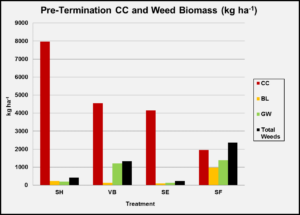
Plant Tissue Nutrient Content: Nitrogen: N concentration in plant tissue was highest in VB at 3.2%, followed by SH at 2.9% (p = 0.0026), and then SF and SE which did not differ at 1.3% and 1.2% N, respectively. PP had 2.3% N.
Phosphorus: P plant tissue level was highest in VB at 0.19% which was not different from SH at 0.17% but greater than SF (0.16%) and SE (0.15%; p ≤ 0.05). PP had 0.16% P.
Potassium: K levels did not differ between SE, SF or VB at 2.4, 2.4, and 2.3%, respectively, but all three were higher than SH at 1.5% K. PP had 2.1% K.
Plant Tissue Nutrient Content at Termination
|
N% |
P% |
K% |
|||
|
SH |
2.9b |
0.17ab |
1.5b |
||
|
VB |
3.2a |
0.19a |
2.3a |
||
|
SE |
1.2d |
0.15c |
2.4a |
||
|
SF |
1.3d |
0.16bc |
2.4a |
||
|
PP |
2.3c |
0.16bc |
2.1a |
|
|
|
Means in the same column with different letters are significantly different (LSMeans, p ≤ 0.05). |
|||||
Potential Nutrient Availability: Estimated total nitrogen contribution in SH was the highest at 231 kg ha-1 which was higher than VB (148 kg ha-1), SE (51 kg ha-1), and SF (28 kg ha-1). Estimated total phosphorus contribution was also highest in SH at 14 kg ha-1); there was no difference between VB, SE and SF potentially available P (9, 6, and 3 kg ha-1, respectively). There was no difference for potentially available K across SH, VB, SE and SF treatments (118, 103, 101, and 53 kg ha-1, respectively).
Potential Nutrient Contribution of Vegetative Biomass at Termination (kg ha-1)
|
N |
P |
K |
|
|
|
SH |
231b |
118b |
14b |
|
|
VB |
148c |
103b |
9c |
|
|
SE |
51d |
101b |
6c |
|
|
SF |
28d |
53b |
3c |
|
|
PP |
310a |
316a |
23a |
|
|
Means in the same column with different letters are significantly different (LSMeans, p ≤ 0.05). |
||||
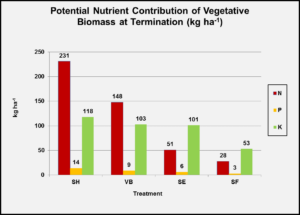
Cover Crop Regrowth and Weed Development after Termination:
3 WAT: SH and SE had similar GW biomass at 5 and 49 kg ha-1 respectively, which was lower than that for VB and SF at 552 and 904 kg ha-1, respectively (p ≤ 0.05). VB had less GW than SF (p = 0.02) which could be attributed to poor VB termination from the roller-crimper resulting in greater regrowth competition with weed species.
6 WAT: SH, VB and SE had 690, 670 and 699 kg ha-1 (respectively) of GW biomass which were lower than SF (1,547 kg ha-1 p ≤ 0.004).
9 WAT: SE GW biomass was 911 and is similar to SH levels of 1,124 kg ha-1 (respectively). VB and SF were not different at 1,677 and 1,513 kg ha-1 (respectively), but both had greater BW than SE (p = 0.0087).
12 WAT: VB, SE and SH had less GW biomass at 1,290, 1,355, and 1,607 kg ha-1 (respectively) compared to SF with 2,649 kg ha-1 (p ≤ 0.01).
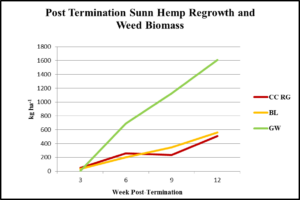

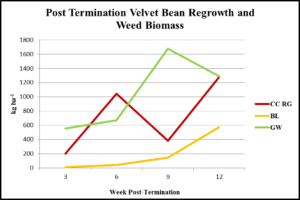
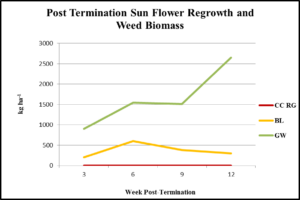
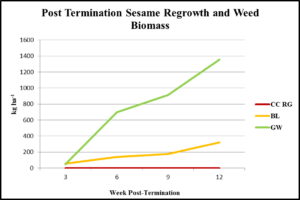
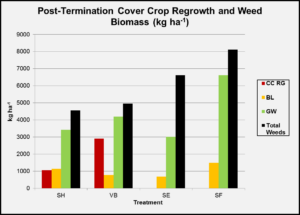
|
Table 3: Cover Crop Regrowth, Broadleaf and Grass Weed biomass kg ha -1 Post-Termination with a Roller-Crimper |
|
||||||||||
|
Weeks after Termination |
|
||||||||||
|
3 wks |
6 wks |
9 wks |
12 wks |
|
|||||||
|
Sunn Hemp Regrowth |
49c |
261cde |
234e |
509de |
|
||||||
|
Grass Weeds |
5c |
690bc |
1124bc |
1607b |
|
||||||
|
Broadleaf Weeds |
32c |
202cde |
345de |
561cde |
|
||||||
|
Velvet Bean Regrowth |
201c |
1045ab |
384de |
1274bcd |
|
||||||
|
Grass Weeds |
552b |
670bc |
1677a |
1290bcd |
|
||||||
|
Broadleaf Weeds |
11c |
44de |
144e |
572cde |
|
||||||
|
Sesame Regrowth |
0c |
0e |
0e |
0e |
|
||||||
|
Grass Weeds |
49c |
699bc |
911c |
1355bc |
|
||||||
|
Broadleaf Weeds |
57c |
140cde |
176e |
322e |
|
||||||
|
Sunflower Regrowth |
0c |
0e |
0e |
0e |
|
||||||
|
Grass Weeds |
904a |
1547a |
1513ab |
2649a |
|
||||||
|
Broadleaf Weeds |
202c |
605bcd |
384de |
301e |
|
||||||
|
Means in the same column with different letters are significantly different (LSMeans, p ≤ 0.05). |
|
||||||||||
|
Table 4: Pigeon Pea Regrowth, Broadleaf and Grass Weed Development Following Termination with a Roller-Crimper in kg ha-1 Post-Termination |
|||||||||||
|
Weeks after Termination |
|||||||||||
|
3 |
6 |
9 |
12 |
||||||||
|
Pigeon Pea Regrowth |
197a |
393a |
18a |
0a |
|||||||
|
Grass Weeds |
4a |
86a |
873b |
3919b |
|||||||
|
Broadleaf Weeds |
84a |
530a |
746b |
3464b |
|||||||
|
Means in the same column with different letters are significantly different (LSMeans, p ≤ 0.05). |
|||||||||||
Objective 1; Puerto Rico: Greater biomass and nitrogen (N) contribution were found for July (summer) planting. This is possibly related to the photosensitive responses of crimped legumes (CL). In fact, dwarf velvet bean produced 1.66 Mg ha-1 and 45.5 kg ha-1 compared to sunn hemp 0.96 Mg ha-1 and 26.33 kg ha-1 of dry matter and N, respectively. Contrast analysis between CL vs. Conventional tillage (CT) and dwarf velvet bean vs. sunn hemp showed no significant differences (P.0.05) in the first planting date on ear yield. However, for the second planting, dwarf velvet bean surpassed (P<0.05) sunn hemp yield by 4.09 Mg ha-1. CT ear yield was better (P<0.05) than the CL (difference >3.63 Mg ha-1) during the third planting. Marketable seed yield showed the same behaviour as ear yield across planting dates. Ear corn damage (1-2 cm) caused by Helicoverpa zea was not significantly different (P>0.05) among the three planting dates in the three systems. Despite the differences in yields with seeding systems, dwarf velvet bean yields were uniform across planting dates.
Objective 2; U.S. Virgin Islands: Sunn hemp and sun flower provided excellent weed suppression (near 100%) during the cover crop cycle. The use of a roller-crimper for cover crop termination was effective for sun flower and sunn hemp, but was not effective for pigeon pea. Sunn hemp surface residue provided similar or greater weed suppression than full tillage for 6 weeks after termination. Sun hemp and sun flower conservation tillage systems produced similar or greater yields of jalapeno peppers compared to conventional full till systems. Pepper yields were greatest in sun flower treatments in year 1 and in sun flower and sunn hemp treatments in year 2. Weekly weeding resulted in greater yields than reduced frequency weeding in year 1 but not in year 2. Sunn hemp and sun flower reduced the negative effects of drought on pepper yields.
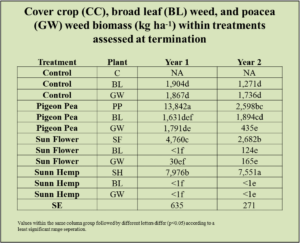
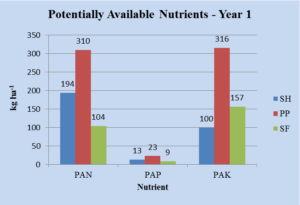
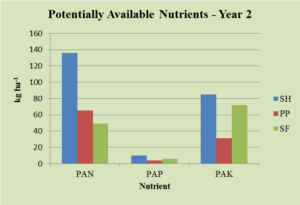
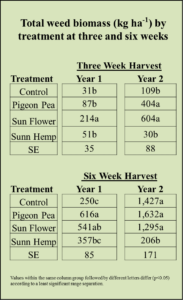
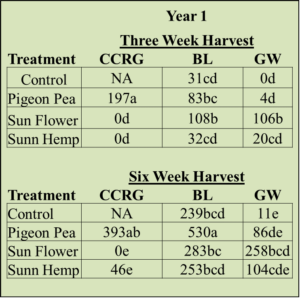


Jalapeno Pepper Yield (kg ha-1) by Treatment, Year, and Weeding Frequency

Objective 2; Puerto Rico: In the laboratory study, there was an interaction between aqueous extracts x agronomic crops on the seventh day of germination. Allelopathic effect was determined by contrasting with the control coleoptile and radicle length in corn and sorghum and, the hypocotyl and radicle length in bean, soybean, cowpea, lettuce and pigeon pea. Sorghum and lettuce showed growth inhibition of the hypocotyl, coleoptile and radicle when treated with the three aqueous extracts, where, jack bean aqueous extracts showed higher inhibitions percentages (66% in lettuce and 49% in sorghum). In contrast, corn, bean and cowpea treated with crotalaria aqueous extracts exhibited growth stimulation. According to these results, field experiments using legume associations with agronomic crops to confirm if the interactions stimulate or inhibit crop development because environmental factors is a major determinant of allelopathic effects.
In the greenhouse study, there was no interaction between agronomic crops x legume mulch for percentage germination at the three dates, but there were significant differences for the main effects of agronomic crops and legume mulch. Contrasts test compared the control versus legume mulch effects on phytotoxic indexes and dry weight on the agronomic crops. The associations of soybean with tropic sun legume mulch and corn with jack bean legume mulch did not show an interaction on any of the indexes. The values were higher than the control. Similarly, tropic sun legume mulch with lettuce and pigeon pea, as well as, soybean with pigeon pea legume mulch, exhibited increases in some indexes. On the other hand, soybean treated with jack bean legume mulch and corn with pigeon pea legume mulch presented allelopathic effects on germination index and dry weight, but bean crop treated with jack bean legume mulch, exhibited effects on dry weight only. The values of these variables were lower than the control. Of the seven agronomic crops evaluated, sorghum and pigeon pea showed no allelopathic effects. The results of these greenhouse study documents allelopathic interference. However, these legume mulch associations should be verified in field studies to consider biological and chemical components as well as environmental factors because these elements are crucial in determining allelopathic interactions.
Objective 3a; Florida and the U.S. Virgin Islands:
Florida: Cover Crop and Weed Biomass at Termination. Sunn hemp above ground dry weight biomass was 9,026 kg ha-1 in 2013 and 6,704 kg ha-1 in 2014 and effectively suppressed weeds during growth. Weed dry weights from the same half meter sample frames were statistically zero in 2013 and 62 kg ha-1 dicots and 346 kg ha-1 monocots in 2014.
Cover Crop Regrowth and Weed Biomass during the Production Season. Sunn hemp regrowth was minimal in Florida both years. While regrowth was observed, the frequency was insufficient to analyse statistically. Both years, primary weeds of economic concern at the sites were yellow nutsedge, crabgrass, morning glory and palmer amaranth. Extensive hand weeding was required within the no mulch treatment both years. As expected, plastic mulch was effective in minimizing weed density and biomass. Consistent with previous literature, the first few weeding events of the season proved to be the most important. That is, where the team did a good job of weeding the plots early in the production season, subsequent weed emergence was reduced in those plots.
|
2013 Total Weed Biomass among mulch systems at 3 and 6 weeks after cover crop termination (kg ha-1) |
|
||||||||
|
|
Mulch System |
||||||||
|
Roller Crimp |
Cut and Carry |
Plastic Mulch |
No Mulch |
SE |
|||||
|
Week 3 weeding event |
16.8 |
c |
46.1 |
b |
3.3 |
c |
82.3 |
a |
8.3 |
|
Weed 6 weeding event |
16.6 |
ab |
0.85 |
b |
4.7 |
ab |
40.22 |
a |
14.8 |
|
Values within the same harvest group row followed by different letters differ (p<0.05) according to a least significant range separation. |
|||||||||
Florida Pepper Yield 2013-2014. In 2013, there were 14 weekly harvests from 8/13/2013 to 11/13/2013. In 2014, there were six weekly harvests from 9/4/2014 to 10/20/2014. Each year, the harvests were interrupted by a hard freeze, and the freeze in 2014 was five weeks earlier than the 30-year average (typically from November 11-20). Each year, plants were in full fruit and could have continued producing sufficient yield to justify continued harvest for several weeks. Therefore, an earlier plant date is recommended for hot pepper in these systems. When data years were analysed together, years were expressed as a significant main effect, as was the mulch system, therefore years were analysed separately. There were no system by weed frequency interactions for years together of years apart. Experiment-wide, plots averaged 17 plants, with each bearing 50 fruit over the course of the season in 2013. The cut and carry treatment was the only treatment with greatest yields both years. This could be due to the initial nitrogen contribution from sunn hemp following soil incorporation combined with the quality of the straw mulch which was slow to decompose and thus moderated soil temperatures during the season. The remaining mulch systems were similar in 2013; there was no yield advantage to utilizing roller-crimped sunn hemp over plastic mulch, but in the longer term it is possible that differences in soil quality could be realized. In 2014, pepper yield from the plastic mulch treatment was similar to yield from the cut and carry treatment, indicating that even with year to year seasonal variations where the plastic might have a slight advantage, the substitution of plant-based mulch has no negative impact on yield. It is important to note that all treatments had sunn hemp prior to initiation of the surface mulch treatment, possibly there were lingering benefits among the treatments that damped the degree of differences among them.
|
University of Florida/IFAS Organic Jalapeno Pepper Yield (Capsicum annum L. ‘Tormenta’) |
||||
|
MANAGEMENT |
Marketable Yield |
Total Yield |
||
|
2013 |
2014 |
2013 |
2014 |
|
|
MULCH SYSTEM |
-------- kg ha-1 -------- |
-------- kg ha-1 -------- |
||
|
Roller-Crimped Sunn Hemp |
16,061 bz |
9,071 b |
20,512 |
9,121 b |
|
Cut and Carry Rye Straw |
22,706 a |
9,856 ab |
23,845 |
9,945 ab |
|
Plastic Mulch |
15,008 b |
10,834 a |
19,056 |
10,937 a |
|
No Mulch |
16,794 b |
7,074 c |
18,611 |
7,121 c |
|
|
P = 0.0063 |
P = 0.0005 |
P = 0.2296 |
P = 0.0004 |
|
WEEDING FREQUENCY |
-------- kg ha-1 -------- |
-------- kg ha-1 -------- |
||
|
Weekly |
18,241 |
9,748 |
21,478 |
9,817 |
|
Every Third Week |
17,044 |
8,669 |
19,535 |
8,745 |
|
|
P = 0.4350 |
P = 0.6024 |
P = 0.3189 |
P = 0.0612 |
1 Values followed by different letters within each year differ (p<0.05) according to a least significant range separation.
|
University of Florida/IFAS Organic Jalapeno Pepper Yield (Capsicum annum L. ‘Tormenta’) |
||||
|
MANAGEMENT |
Marketable Yield |
Total Yield |
||
|
2013 |
2014 |
2013 |
2014 |
|
|
MULCH SYSTEM |
-------- kg ha-1 -------- |
-------- kg ha-1 -------- |
||
|
Roller-Crimped Sunn Hemp |
16,061 bz |
9,071 b |
20,512 |
9,121 b |
|
Cut and Carry Rye Straw |
22,706 a |
9,856 ab |
23,845 |
9,945 ab |
|
Plastic Mulch |
15,008 b |
10,834 a |
19,056 |
10,937 a |
|
No Mulch |
16,794 b |
7,074 c |
18,611 |
7,121 c |
|
|
P = 0.0063 |
P = 0.0005 |
P = 0.2296 |
P = 0.0004 |
|
WEEDING FREQUENCY |
-------- kg ha-1 -------- |
-------- kg ha-1 -------- |
||
|
Weekly |
18,241 |
9,748 |
21,478 |
9,817 |
|
Every Third Week |
17,044 |
8,669 |
19,535 |
8,745 |
|
|
P = 0.4350 |
P = 0.6024 |
P = 0.3189 |
P = 0.0612 |
1 Values followed by different letters within each year differ (p<0.05) according to a least significant range separation.
U.S. Virgin Islands: Sunn hemp biomass measured 7,208 kg ha-1 containing 2.5% nitrogen and suppling an estimated range of potentially available nitrogen of 168 to 226 kg ha-1to the cropping system. Weeds were effectively controlled prior to CC termination with total weed biomass measuring 131 kg ha-1. The sunn hemp mulch treatment had greater total weed biomass than all other treatments at 3 and 6 weeks and at 9 and 12 weeks after termination for the low intensity weeding frequency. In the USVI, there was a marketable yield x weeding frequency interaction and marketable yield is presented independently for low and high intensity weed removal frequencies. When the sunn hemp residue was tilled into the soil and additional cut and carry straw mulch is utilized, then yields were similar to or exceeded those from all other mulching systems evaluated.
Sunn Hemp and Weed Biomass at Termination kg ha-1
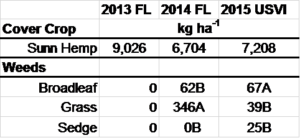
Total Weed Biomass at 3 and 6 Weeks Post Termination kg ha-1
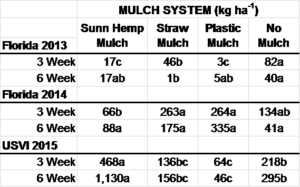
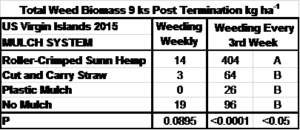
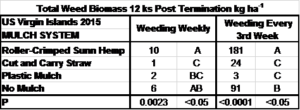
Marketablke Pepper Yield in the U.S. Virgin Islands (kg ha-1)

Objective 3a; Puerto Rico: At Isabela, in the first planting of LCC, weeds were observed in the CP (>3.0 Mg ha-1), but not in the LCC (100% of control). In subsequent LCC plantings, weeds were not sampled because the amount was low due to shade from plantains. There were significant differences (p<0.05) between integrated legume system (ILS) planting dates. The first planting (June-September) provided greater amount of N (244 Kg N ha-1) because in this planting there was the highest DM yield. There was not an interaction (p>0.05) between treatments x grow stage for height and pseudostem diameter (3 m and 15 cm, respectively) were found, however significant differences (p<0.05) were found between treatments for potassium (K), in which Jack bean ILS showed higher concentration (2.8%). The other nutrients were not affected. There was no significant difference between treatments to the yield of Maricongo (35 Mg ha-1). At Corozal, there was significant differences (p<0.05) between LCC planting, where the first planting (June-September) contributed the greatest amount of N (75 Kg N ha-1), because this period had the highest DM yield. There was an interaction (p<0.05) between treatments x growth stage of the Maricongo clone for pseudostem diameter and foliar concentrations of K and magnesium (Mg), but not for plant height. At five months and flowering ‘Tropic Sun’ ILS had the highest diameter (17 cm) and also the highest concentration of K (4.5%) vs. the other treatments. In addition, at five and seven months, Jack bean ILS was significantly different from the CP with regard to Mg concentration (0.22 and 0.18% Mg). The other nutrients were not affected by LCC. These results showed that ILS controlled weeds, provided N, and K and Mg were more available, but did not affect the plantain yield. Therefore, long-term studies assessing fertilizer levels through a soil test before legume planting (pre planting) is recommended. Also, in the mountain region using perennial living mulches like Jack bean and Forage peanut to weeds control between rows and plants of plantain.
Objective 3b; U.S. Virgin Islands: Above-ground biomass of sunn hemp at termination did not differ between fields; and measured 3,717 kg ha-1 in field 1 and 4,367 kg ha-1 in field 2. Total weed biomass was also similar between fields 1 and 2 prior to sunn hemp termination. Weekly weed removal in the high frequency sub-plots resulted in similar weed biomass across all treatments at 3, 6, and 9 weeks after transplant (WAT). In the Low Frequency, three-week weed removal subplots, in-bed weed suppression differed by treatment. At 3 WAT, weed suppression was greatest for SHM+fabric, followed by SHM+hay, and lowest for SHM and SH+none treatments. At 6 WAT, SHM+fabric provided the greatest in-bed weed suppression with the lowest weed biomass and similar weed biomass for the remaining treatments in field 1. In field 2, SHM+fabric suppressed weeds as well as SH+none and SHM+hay. A similar trend was observed at 9 WAT for both fields as described for field 1. Similar pepper yields were recorded for both low and high frequency weed removal sub-plots. This implies that 3 week weed removal intervals are generally as effective as weekly weed removal and could greatly reduce weed removal labor costs in organic hot pepper production. Generally, weed biomass in the full-till SH+none and the reduced tillage SHM treatments were similar and implies that full soil tillage does not necessarily correlate to reduced weed biomass compared to no-till vegetable cropping systems. Overall, the SHM+fabric and SHM+hay treatments had the greatest Jalapeno yields with no differences between the SHM and SH+none treatments. Serrano pepper yields were greatest in the SHM+fabric, SHM+hay, and SH+none treatments. The greatest pepper yields resulted from insitu sunn hemp mulch plus the application of an additional mulch.





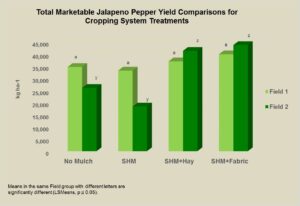
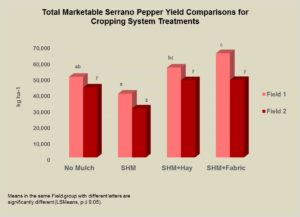
Educational & Outreach Activities
Participation summary:
USVI and UF Conference Proceedings:
Objective 1: To assess velvet bean (Mucuna pruriens L. cv. Vine 90), sunflower Helianthus annus L. cv. Black Oil), sesame (Sesamum indica L. cv. ns), pigeon pea (Cajanus cajan L. cv. BRS Mandarim), and sunn hemp (Crotalaria juncea L. cv. IAC-1) as cover crops and evaluate the effectiveness of cover crop termination using a roller-crimper to create in situ mulch for subsequent use in no-till vegetable cropping systems.
Weiss, S.A. 2012. Evaluation of Three Cover Crops and Their Termination with a Roller-Crimper to Produce Residual Surface Sheet Mulch on Cover Crop Re-Growth and Weed Development under Tropical Environmental Conditions. In: International Annual Meetings ASA-CSSA-SSSA; 52-6. Available at: https://scisoc.confex.com/crops/2012am/webprogram/Paper73941.html
Weiss, S.A. and K.P. Beamer. 2013. Reduced Tillage Termination of Cover Crop Systems in the Tropics. In: International Annual Meetings ASA-CSSA-SSSA; 187-3. Available at: https://scisoc.confex.com/scisoc/2013am/webprogram/Paper81559.html
Weiss, S.A. and K.P. Beamer. 2014. Evaluation of Three Cover Crops Terminated with a Roller- Crimper on Cover Crop Re-Growth and Weed Development under Tropical Conditions. Proc. Caribbean Food Crops Society. 50:41.
Weiss, S.A. and K.P. Beamer. 2014. Screening of Five Broad Leaf Plants for Use as Tropical Cover Crops and their Response to Termination with a Roller-Crimper. In: International Annual Meetings ASA-CSSA-SSSA; 66-21. Available at: https://scisoc.confex.com/scisoc/2014am/webprogram/Paper89776.html
Objective 2: To evaluate and compare five tropical cover crop species to each other and to a weedy fallow in rotation with a subsequent no-till hot pepper (Capsicum chinense Jacq.) rotation where the cover crops were terminated with a roller-crimper to produce in situ mulch for weed suppression and to improve soil quality. Cover crop varieties to be tested included velvet bean (Mucuna pruriens L. cv. Vine 90), sunflower (Helianthus annus L. cv. Black Oil), sesame (Sesamum indica L. cv. ns), pigeon pea (Cajanus cajan L. cv. BRS Mandarim), and sunn hemp (Crotalaria juncea L. cv. IAC-1).
Weiss, S.A., D.D. Treadwell, E. Valencia, and K.P. Beamer. 2013. Tropical Cover Crop Mulch Systems for Low-External-Input Reduced Tillage Crop Production. In: International Annual Meetings ASA-CSSA-SSSA; 317-11. Available at: https://scisoc.confex.com/scisoc/2013am/webprogram/Paper81549.html
Weiss, S.A., D.D. Treadwell, R.S. Ferrarezi, and K.P. Beamer. 2015. Tropical Cover Crop Mulch Systems for Low-external-input Reduced-tillage Vegetable Production. HortScience 50(9) (Supplement).
Weiss, S.A., D.D. Treadwell, R.S. Ferrarezi, and K.P. Beamer. 2015. Utilizing the Cover Crop Sunn Hemp (Crotalaria juncea L.) to Improve Vegetable Cropping Systems. In: International Annual Meetings ASA-CSSA-SSSA; 301-2. Available at: https://scisoc.confex.com/crops/2015am/webprogram/Paper95099.html
Objective 3: To evaluate sunn hemp as a cover crop rotation with hot pepper production where the crop residue is either mechanically (roller-crimper) killed for in situ surface sheet mulch or is green chopped and soil incorporated to determine effects on soil quality and weed suppression in comparison to three common cultural weed management practices.
Treadwell, D.D., S.A. Weiss, and J. Perez. 2015. Cover Crops and Conservation Tillage in Organic Jalapeno Pepper (Capsicum annum L. ‘Tormenta’). HortScience 50(9) (Supplement).
Treadwell, D.D., and S.A. Weiss. 2015. A Comparison of Tillage and Mulching Strategies for Weed Management in Organic Pepper (Capsicum annum L. ‘Tormenta'). In: International Annual Meetings ASA-CSSA-SSSA; 258-12. Available at: https://scisoc.confex.com/crops/2015am/webprogram/Paper94073.html
Weiss, S.A., D.D. Treadwell, R.S. Ferrarezi, and K.P. Beamer. 2016. Mulching Strategies using Conservation Tillage for Weed Management in Tropical Organic Hot Pepper Cropping Systems. HortScience 51(9): (Supplement).
Weiss, S.A., D.D. Treadwell, R.S. Ferrarezi, K.P. Beamer, and T. Geiger. 2016. PrimaryMacronutrient Dynamics of Sunn Hemp (Crotalaria juncea L.) Residue in Different Mulching Strategies for Organic Tropical Cropping Systems. In: International Annual Meetings ASA-CSSA-SSSA.
Objective 4: To demonstrate and transfer results from the first 3 objectives to local farmers, agriculture extension and outreach personnel, and federal agricultural agencies throughout the USVI, PR, and Florida.
Treadwell, D.D. S.A. Weiss, E. Valencia, and K.P. Beamer. 2014. Lessons Learned in Conservation Tillage Vegetable Systems in the Sub-Tropics and Tropics. HortScience 49(9):S329 (Supplement).
Weiss, S.A., D.D. Treadwell, and R. Archuleta. 2016. Cover crop surface mulch for conservation-tillage vegetable cropping systems. In: Southern Cover Crop Conference: 25-26. July 18-19, 2016. Mount Olive and Goldsboro, North Carolina. Available at: https://www.ncsu.edu/mckimmon/cpe/opd/CEFS/pdf/programBook.pdf
Treadwell, D.D., S.A. Weiss, and R. Archuleta. 2016. Mechanical termination of three physiologically distinct cover crop species. In: Southern Cover Crop Conference: 25. July 18-19, 2016. Mount Olive and Goldsboro, North Carolina. Available at: https://www.ncsu.edu/mckimmon/cpe/opd/CEFS/pdf/programBook.pdf
Puerto Rico:
Conference Proceedings:
Martinez, E., E. Valencia, J. Beaver y H. Cuevas. 2014. Efectos alelopaticas de Crotolaria (Crotalaria juncea cv. Tropic sun), Gandul (Cajanus cajan) y Canavalia (Canavalia ensiformis) sobre la germincacion de semillas de cultivos tropicales. Abst. CFCS ST. Thomas, US Virgin Islands, 6-11 July, 2014.
Parreño, J., E. Valencia, D. Jenkins, R. Goenaga y J. Ortiz. 2014. Impacto de sistemas integrados de platanos (Musa sp.) sobre malezas y aportaciones de N. Abst. CFCS, ST. Thomas, US Virgin Islands, 6-11 July, 2014. Martinez, E., E. Valencia, J. Beaver and H. Cuevas. 2014. Crimped cover crop legume residue effects on Sweet Corn (Zea mays L.) yield in Puerto Rico. Abst. American Soc. of Agronomy, Long Beach, CA. November 2014.
Parreno, J., and E. Valencia. 2014. Legume cover crops effects on plantain (Musa acuminata x balbisiana) cv. Maricongo growth in Puerto Rico. Abst. American Soc. of Agronomy, Long Beach, CA. November 2014.
Publications:
Martínez, E., E. Valencia and H. Cuevas. 2015. Yield evaluation of sweet corn (Zea mays L. cv. Suresweet) with cover crops dwarf velvet bean (Mucuna pruriens) and crotalaria (Crotalaria juncea cv. Tropic sun) on an oxisol of Puerto Rico. J. Agric. Univ. P.R.
Martínez, E., E. Valencia, y H. Cuevas. 2015. . Allelopathic evaluation of agronomic crops using legume mulch of crotolaria [Crotalaria juncea cv. Tropic Sun], canavalia [Canavalia ensiformis (L)] and pigeon pea [Cajanus cajan cv. Lazaro] in the greenhouse. J. Agric. Univ. P.R. Accepted
Martínez, E. E. Valencia, y H. Cuevas. 2015. Allelopathic effects of aqueous extracts ofthe legumes crotalaria [Crotalaria juncea (L.) cv. Tropic Sun], jack bean [Canavalia ensiformis (L.)] and pigeon pea [Cajanus cajan (L.) cv. Lazaro] on crop development. J. Agric. Univ. P.R.
Velázquez, W., E. Valencia, y A. M. Linares. 2015. Efecto de las cobertores Crotalaria juncea y Helianthus annuus y niveles de nitrógeno en la producción de pimento (Capsicum annuum). Resumen. Sociedad Puertorriqueña de Ciencias Agrícolas, 2015.
SARE Cover Crop and Soil Health Workshop Report for St. Croix and Puerto Rico, April 2014
Tropical Cover Crops and Soil Health Workshop and Field Day – Held April 3 and 4, 2014, sponsored by UVI-AES SARE Research and Education Grant, and conducted by Dr. Stuart Weiss. This workshop was a collaborative effort funded by the SARE Research and Education grant “Developing Sustainable Tropical Leguminous Cover Crop and Green Manure Mulch Systems for Low-External-Input crop Production in the U.S. Virgin Islands, Puerto Rico, and Florida”.
Collaboration for the event was provided by the University of Florida, Horticultural Sciences Department and the University of Puerto Rico, Agronomy Department. Co-PIs for the project travelled to the University of the Virgin Islands Albert A. Sheen campus on St. Croix to participate in the event and provide additional technical expertise. Dr. Danielle Treadwell, Professor of Organic and Sustainable Agriculture from the Horticultural Science Department at the University of Florida and Dr. Elide Valencia, Professor of Agronomy at the University of Puerto Rico, Mayaguez, Puerto Rico conducted seminars on April 3, 2014 and provided technical assistance with the field tour on April 4, 2014. The University of the Virgin Islands Cooperative Extension Service assisted in the event by providing planning and logistical support. Carlos Robles organized two farmers from the St. Thomas farming community to travel to the workshop and assisted in workshop logistics and operations. Carlos Robles was the Territorial SARE Coordinator in 2014 and provided a hard copy of “Managing Cover Crops Profitably” to all of the farmer attendees. Stafford Crossman assisted in coordinating farmer attendance from the St. Croix farming community. Rudy O’Reily and Julie Wright from the St. Croix USDA-NRCS department attended and provided sponsorship which included published NRCS educational materials on soil health from there “Unlock the Secrets in the Soil” series. There were 45 participants in the two day event that included U.S. Virgin Island farmers (36), government agencies (3), and UVI AES/CES professionals (6). Seminar presentations included:
Soil Health Planning Principles & Cover Crop Management Strategies for the Virgin Islands by Stuart Weiss, Assistant Professor of Agronomy, University of the Virgin Islands.
Cover Crop Rotations in Vegetable Production Systems by Danielle Treadwell, Horticultural Sciences, University of Florida and Stuart Weiss, Assistant Professor of Agronomy, University of the Virgin Islands.
Cover Crop Rotations for Plantain, Banana, and Corn Production in Puerto Rico by Elide Valencia, Agronomy Department, University of Puerto Rico, Mayaguez, Puerto Rico.
Soil quality, soil aggregation, and soil structure were taught through classroom and field demonstrations. Different cover crop and vegetable crop systems were explored and management principles were conveyed through mixed field demonstrations. Demonstrations included viewing different soil pits that were prepared in different fields based upon land use and soil management practices (e.g. continuous long-term full tillage, reduced tillage with cover crops, and long-term permanent pasture no-tillage). Other active demonstrations included roller-crimper termination of sunn hemp and lab lab, and experimental field tours of test plots with jalapeno peppers planted into sunn hemp, velvet bean, and sunflower in situ cover crop residue.
On April 8, 2014 a similar seminar and field day was conducted for farmers and agricultural professionals at the University of Puerto Rico Agricultural Experiment Station at Isabella, Puerto Rico and hosted by Dr. Elide Valencia. Stuart Weiss conducted a seminar and provided program assistance to the field workshop that explored collaborative research projects associated with the SARE Research and Education Grant. Dr. Elide Valencia provided 2 seminars and provided field tours of SARE research projects. Presentations were made by three UPRM graduate students supported by the SARE grant. Dr. Danielle Treadwell also provided key technical support and conducted a presentation to attendees on SARE research conducted at the University of Florida. There were 30 participants that attended the Isabella, Puerto Rico Cover Crop and Soil Health Workshop.
SARE Discover the Cover IPM and Soil Health Workshop Report for Florida, June 4, 2015
On June 4, 2015, Treadwell co-hosted a Discover the Cover workshop with Bob Hochmuth, Regional Specialized Vegetable Agent in Suwannee Valley Agricultural Extension Center near Live Oak, FL. Treadwell was a collaborator with Hochmuth on a second SARE on-farm grant to evaluate cover crops as beneficial habitat on a U-Pick Blueberry Farm. The agenda included 90 minutes of formal instruction, followed by dinner (paid for by attendee registrations), a tour of Treadwell’s research plots and cover crop roller crimper demonstration, and finally a tour of the farmer collaborator’s farm (Rooney’s Front Porch Farm). CEUs were made available for pesticide applicators and certified crop advisors. Both sites were visited by SR-SARE Public Relations Coordinator Candice Pollock early in the year, hosted by Treadwell and Hochmuth. There were 45 in attendance, primarily farmers. A pre and post-test evaluation was administered, and 35 attendees responded. Knowledge of cover crop management strategies, risks, and benefits increased 30%, although for some respondents, knowledge gain was as high as 68%. As a result of this workshop, 91% indicated they plan to integrate cover crops on their farm, and 86% indicated they were confident on cover crop management. When asked to reflect what benefits farmers anticipated from cover crops used on their own farms, pest management, weed management, and improved soil health were the primary objectives. The study was important to the UF/IFAS SVAEC as it was located on certified organic land and the station receives many visitors each year. Updates of research progress were shared through the UF/IFAS Small Farms Academy Facebook page. Study summaries and preliminary data were also shared with approximately 320 undergraduate and graduate students at UF during 3 guest lectures on organic farming, cover crop management, and sustainable agriculture.
Southern Cover Crops Conference: Project results were presented at the Southern Cover Crops Conference (S-SARE sponsored) held in North Carolina on July 18 and 19, 2016. Results were disseminated through two practical demonstration that occurred on day two of the conference. The two demonstrations were “Mechanical termination of three physiologically distinct cover crop species” and “Cover crop surface mulch for conservation-tillage vegetable cropping systems”. There were over 300 people in attendance at the conference that included agricultural professionals, agricultural agency personnel, and farmers. I was personally told by numerous attendees that it was the most informative set of field demonstrations that they had ever participated in.
Project Outcomes
U.S. Virgin Islands: SH produced the greatest biomass levels with relatively high plant tissue N content that resulted in SH having the highest estimated N and P contribution potential for returning nutrients back to the farming system. The SH cover crop contained 231 kg ha-1 at termination. Both SE and SH were effective at suppressing both BW and GW during cover crop establishment. SH, SE, and SF were effectively terminated with a roller crimper while VB was not, as evidenced by substantial levels of VB regrowth following roll down with the roller-crimper. Following termination, SE and SH cover crop surface residue has the greatest potential for suppressing weed development for 6 weeks. Due to slow germination and a long establishment period to reach physiological maturity (150+ days), PP is not considered a good candidate for use in short-cycle vegetable crop rotations. However, PP did produce extremely high amounts of biomass that contained high N, P, and K that resulted in high PNA levels to the farming system (310 kg ha-1 of N, 23 kg ha-1 P, and 316 kg ha-1 of K). Therefore, PP could serve as an excellent long-cycle cover crop or as use as a conservation cover or buffer.
Puerto Rico: There has been an increase in purchase of Crotalaria and Canavalia seeds for use as cover crop in horticulture and fruit trees. There is extensive use of Canavalia to smother weeds and control nematodes in plantains exist throughout Puerto Rico. Our study showed that Canavalia is shade tolerant; hence use extended in greenhouse use for pepper production.
Two graduate students that were fully funded with project funds defended their thesis in December, 2015 and graduated. An additional graduate student that was partially funded by project funds defended their thesis in December, 2015 and graduated.
Objective 2; U.S. Virgin Islands: Cover crops can be a valuable management tool in the tropics that require few if any external inputs. For indeterminate, warm season cover crops, roller-crimper termination may not be viable without additional management. Peppers can be no-till transplanted into sunn hemp and sunflower cover crop residue in situ mulch that produce yields that equal or exceed conventional yields using full tillage practices. Cover crops terminated with a roller-crimper for in situ mulch may suppress weeds and lessen the effects of extreme environmental conditions on subsequent crop yields.
Objective 2; Puerto Rico: Cover crop allelopathy can both positively and negatively affect vegetable cropping systems. Allelopathy of cover crops that suppresses weed development in subsequent crop rotations will provide vegetable crop system benefits. However, if allelopathy resulting from cover crop and their residues when used as in situ mulch supress vegetable crop germination, development, and yields, then farm profitability will be reduced. Therefore, it is critical that the allelopathic characteristics of cover crops be understood in order to make accurate and beneficial recommendations about cover crop use for integrated vegetable crop systems.
Objective 3a; Florida and the U.S. Virgin Islands:
The objective for Florida was to evaluate sunn hemp as a CC/GM rotation with hot pepper (Capsicum chinense Jaq.). Methodology used, and the outcomes recorded will be applied to replicate trials in PR and USVI. There are several observations about the system that were made in Florida and corrected for in the USVI, as per the strategy outlined in the initial proposal. Planning a staggered start for the same experiment allowed the team to respond to things that were not working well prior to planting in the next location.
One of the most important contributions of this work is the development of specific recommendations for conservation tillage pepper. Initially, Ahi Dulce pepper was selected, establishment was poor. This may have been related to seed quality, or the cooler than average early summer temperatures. Pepper is an excellent model crop for conservation tillage systems due to its single, sturdy stem, tolerance to heat, and prolific yield. Overall, insect pests were not of economic importance. Plants did lag somewhat immediately following transplanting; theoretically due to short term nitrogen depression as a result of heavy residue and high soil temperatures at planting. An additional possible constraint in rain fed systems would be the mulch absorbs precipitation, and if rainfall is limited very little water would percolate to plant roots during dry spells. Larger transplants with more established root systems that occupy a larger soil volume could provide some risk reduction, but they have an additional cost. Applying the cut and carry mulch after transplant roots have left the original transplant media was a better solution than applying mulch at the same time as transplanting because the plants were taller and emerged above the mulch layer where air circulation was favourable and light interception optimized.
Cover crop management and the proper timing of cover crop termination followed by pepper transplanting is critical to system performance. Delayed termination and an extended interval between roller-crimping and pepper transplant resulted in a decrease in weed control for the roller-crimped SH treatment. Precise cropping system management is needed to fully achieve the benefits of integrated vegetable cropping systems. Reduced tillage from the adoption of roller-crimped SH can provide additional ecosystem service benefits to the agroecosystem that result in both increased direct and indirect farm profitability.
Objective 3a; Puerto Rico: Conventional plantain and banana production relies heavily upon conventional full tillage and pesticides to control both arthropods and weeds. The use of legumes as intercrops between banana/plantain rows can significantly decrease soil tillage and pesticide use. Overall, cropping system sustainability can be increased, input costs decreased, and yields either maintained or increased compared to those observed in conventional banana/plantain production systems.
Objective 3b; U.S. Virgin Islands: Cover crop management and the proper timing of cover crop termination followed by pepper transplanting is critical to system performance. Low to moderate SH biomass resulted in a decrease in weed control for the SHM treatment. A reduced weeding frequency at 3 week intervals may be adopted by farmers to reduce weed control costs without compromising pepper yields. Precise cropping system management is needed to fully achieve the benefits of cover crops and no-till in integrated organic vegetable cropping systems.
Economic Analysis
There were no economic analyses conducted with this project.
Farmer Adoption
U.S. Virgin Islands: During the research grant period, many farmers were able to view research projects and view the management practices taking place in the many studies conducted over the four year study period. As a result, three additional farmers are using cover crops and currently have cover crops planted on their farms. As a result of cover crop interest and education generated from this study six farmers attended the first Southern Cover Crops Conference (S-SARE sponsored) held in North Carolina on July 18 and 19, 2016.
Puerto Rico:
An on-farm study in March 2014, at farmer co-operator Carlos Gonzalez to assess the effect of three cover crops (crotalaria, canavalia and pigeon pea) has shown positive results in minimizing the bunchy top virus. Canavalia will be used as cover crop in rotation with pepper production in greenhouse studies this spring. Both in 2015 and 2016, fields of velvet bean and canavalia were established and utilized as cover crop on-farm trials and as demonstrations in farmer training workshops. Sunn hemp is now being used as a leguminous intercrop with papaya by several Puerto Rican farms. Leguminous cover crop seeds are available through the Agriculture Experiment Station and large amounts of cover crop seeds are now available through a commercial seed shop available in Puerto Rico.
Florida:
Florida’s plan of work did not include an on-farm study, but the research plots were visited by farmers on several occasions in addition to the formal workshop. During state Extension outreach and educational events and following the Discover the Cover workshop, at least five farmers responsible for 2,200 acres of vegetable production contacted Treadwell for follow-up questions about cover crop species recommendations for their crop rotation as well as establishment and termination advice, and proceeded to plant cover crops successfully.
Areas needing additional study
The majority of effort to date on conservation tillage vegetable production has been focused on individual crop and cover crop combinations for a specific season: broccoli following hairy vetch and rye in Virginia (R. Morse), pumpkins following hairy vetch and rye in North Carolina (G. Hoyt), and this trial, evaluating summer covers prior to fall pepper. Based on our observations, residual rotational effects of cover crop and tillage management strategies are persistent through the next crop cycle, and sometimes two or more cycles, depending on the treatment. The primary observational evidence of this were changes in weed species diversity and biomass. A logical progression of development of these systems includes an evaluation of conservation tillage vegetable crop strategies integrated into the farming system rotation. Farming system rotations need not necessarily be inclusive of only conservation tillage approaches, but could include a combination of full and reduced tillage crops. Integration of even one season of conservation tillage could be a step in a positive direction towards improved soil health and soil conservation, but that needs to be tested and validated.
This project was focused on the needs of small, diversified fruit and vegetable producers in the tropics and subtropics. Much of the work was completed by hand to be consistent with current methods of crop production by farmers. However, these systems need not be limited to small scale operations. This project afforded the Florida-USVI St. Croix research team an opportunity to demonstrate the ecological potential of conservation tillage vegetables. To scale up, production efficiencies including modifications of existing equipment, farming system rotation, and pest and fertility management strategies need to be addressed. While weed management remains a significant challenge for organic producers, scaling up conservation tillage systems to larger acreage will require new mechanical strategies to maintain surface residue while keeping weed density below economic threshold levels. Ideally, heavy residue systems combined with appropriate cultivation with modified tools will keep the number of cultivations to a minimum, thus conserving soil quality and minimizing energy and labor demands.
Finally, there is a limited number of cover crop species that respond to roller-crimper termination in the tropics. Identifying germplasm that is day neutral and does not have a tendency to produce adventitious stems would be more likely to have a complete termination. Regrowth with many species commonly used in temperate climates is a challenge for producers and requires additional management.
Information Products
- Screening of five broad leaf plants for use as tropical (warm season) cover crops
- Evaluation of Three Cover Crops and Their Termination with a Roller Crimper to Produce In Situ Mulch Under Tropical Conditions
- Tropical Cover Crop Mulch Systems for Low-external-input Reduced-tillage Vegetable Production
- Discover the Cover - Soil Health Workshop Seminar
- Utilizing the cover crop Sunn Hemp (Crotalaria juncea L.) to improve vegetable cropping systems
- Mulching Strategies using Conservation Tillage for Weed Management in Tropical Organic Hot Pepper Cropping Systems
- Lessons Learned in Conservation Tillage Vegetable Systems in the Sub-Tropics and Tropics